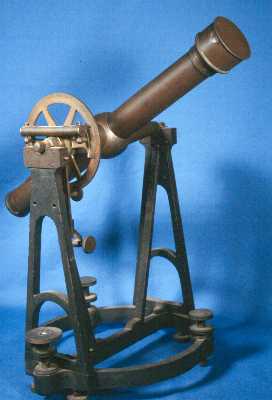| The Transit instrument at Kenyon College was originally
placed on a solid, stone ledge in a southward-facing window in the observatory
in the tower of Ascension Hall (1859). The main telescope was a 4" instrument
with a lens made, in local legend, by Alvan Clark. Tall trees and light pollution
have caused the observatory to be moved; the telescope is now in the Smithsonian
Institution collection, and the transit is in storage in the Kenyon physics
department.
Astronomical transits have telescopes pivoted in the
vertical plane, and accurate angular measurements can be made of the relative
vertical position of a star using the divided circles. Normally the transit
was set to the vertical plane was that of the meridian. A clock next to the
instrument allowed the astronomer to note the time when the star passed the
meridian.
|

|